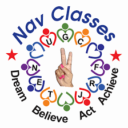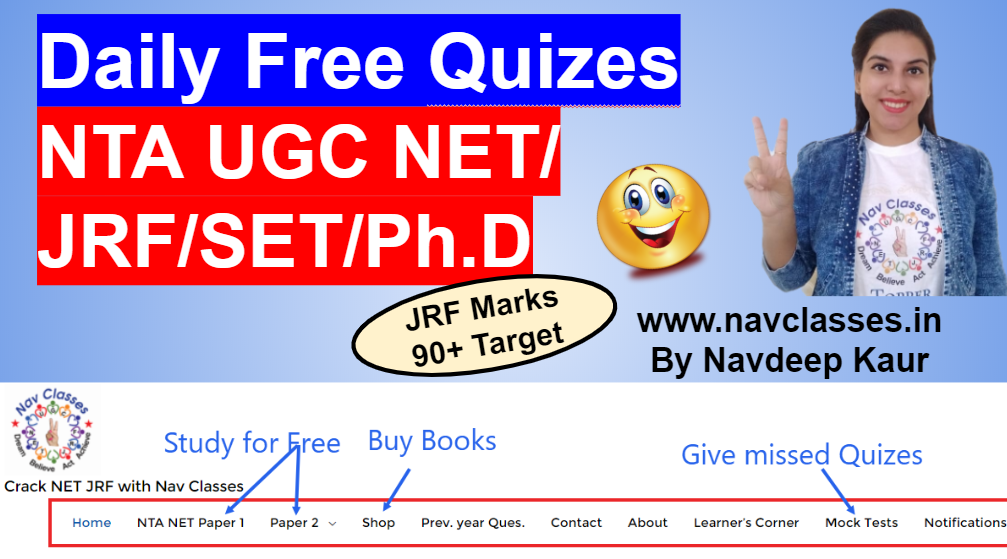1. Identify the chronological sequence of the following countries opting for educational broadcasting channels.
(A) Great Britain
(B) The United States
(C) Australia
(D) India
(E) Canada
Choose the correct answer from the options given below:
1. (C), (D), (E), (A), (B)
2. (B), (A), (E), (C), (D)
3. (D), (E), (B), (C), (A)
4. (A), (B), (D), (E), (C)
SHOW ANSWER
Explanation: It is chronological sequence of countries opting for educational broadcasting channels: US, Great Britain, Canada, Australia, then India. ©navclasses
2. Poor listening by the audience leads to:
1. Appreciating the speaker.
2. Inaccurate inferences.
3. Wild imaginations.
4. Disrespecting the speaker.
SHOW ANSWER
Explanation: > Due to poor listening habits, audiences cannot understand messages correctly and make inaccurate inferences.
> Appreciating is a sign of good listening.
> Wild imaginations are to think of anything or out of the box.
> Disrespect is due to the speaker’s behaviour.
©navclasses
3. Given below are two statements:
Statement I: Free and unlimited use of non-verbal cues enhance the communicative aspects of classroom teaching.
Statement II: A pleasant persona of the teacher enlivens the classroom ecosystem.
In the light of the above statements, choose the correct answer from the options given below:
(1) Both Statement I and Statement II are true.
(2) Both Statement I and Statement II are false.
(3)Statement I is correct but Statement II is false.
(4)Statement I is incorrect but Statement II is true.
नीचे दो कथन दिए गए हैं: कथन I: गैर-मौखिक संकेतों का मुफ्त और असीमित उपयोग कक्षा शिक्षण के संचार पहलुओं को बढ़ाता है। कथन II: शिक्षक का एक सुखद व्यक्तित्व कक्षा के पारिस्थितिकी तंत्र को जीवंत करता है। उपरोक्त कथनों के आलोक में नीचे दिए गए विकल्पों में से सही उत्तर का चयन कीजिए:
SHOW ANSWER
Explanation: Non verbal cues (hints) should not be overused and access to anything impacts wrongly.
> The teacher’s friendly personality brings life to the classroom ecosystem.
©navclasses
4. Match List I with List II.
(Authors) (Communication concepts)
(A) Aristotle (I) SMCR – Sender, message, channel – receiver – model
(B) Shannon and Weaver (II) Circular communication
(C) Wilbur Schramm (III) Speaker – Centred communication
(D) David Berlo (IV) Top-down, linear communication
Choose the correct answer from the options given below:
(A)-(I), (B)-(II), (C)-(III), (D)-(IV)
1. (A)-(II), (B)-(III). (C)-(IV), (D)-(I)
2. (A)-(III), (B)-(IV), (C)-(II), (D)-(I)
3. (A)-(IV), (B)-(I). (C)-(III), (D)-(II)
SHOW ANSWER
Explanation: > Aristotle model is sender centered linear includes:
1. Speaker
2. Speech
3. Occasion
4. Audience
5. Effect
> Shannon and Warren Weaver model is linear, mathematical model of communication (binary mathematical model) includes:
Sender: Businessman, Encoder: Telephone network company,
Channel: Mobile network,
Noise: Missing text due to disruption,
Decoder: Mobile phone,
Receiver: Worker.
> Schramm model is the most circular interpersonal model having continuous feedback.
> David Berlo linear model includes: Sender – Message – Channel – Receiver (SMCR).
©navclasses
5. The consequences of effective classroom communication are:
A. Enhanced expectations of teachers from students.
B. Learning is a satisfying pursuit.
C. Increased promotional prospects for teachers.
D. Enabling students to achieve goals.
E. Positive learning outcomes.
Choose the correct answer from the options given below:
(1) (A), (B), (C) only
(2) (B), (C), (D) only
(3) (C), (D), (E) only
(4) (B), (D), (E) only
प्रभावी कक्षा संचार के परिणाम हैं:
A. छात्रों से शिक्षकों की बढ़ी हुई अपेक्षाएँ।
B. सीखना एक संतोषजनक खोज है।
C. शिक्षकों के लिए पदोन्नति की संभावनाओं में वृद्धि।
D. छात्रों को लक्ष्य हासिल करने में सक्षम बनाना।
ई. सकारात्मक सीखने के परिणाम।
नीचे दिए गए विकल्पों में से सही उत्तर चुनें:
SHOW ANSWER
Explanation: Teachers do not communicate for promotional aspects.
We just eliminate options and get the correct answer as all others are positive statements.
©navclasses
6. Match List I with List II.
(Examples of communication barrier) (Types of communication barrier)
(A) Unclear printing in a newspaper (I) Psychological noise
(B) Different understanding of the (II) Cultural stereotyping message
(C) Passive audience reception of the (III) Physical noise message
(D) Prejudice against certain ethnic (IV) Semantic noise groups
Choose the correct answer from the options given below:
1. (A)-(IV), (B)-(III), (C)-(I), (D)-(II)
2. (A)-(II), (B)-(I), (C)-(IV), (D)-(III)
3. (A)-(III), (B)-(IV), (C)-(I), (D)-(II)
4. (A)-(I). (B)-(II), (C)-(III), (D)-(IV)
SHOW ANSWER
Explanation: > Printing mistakes is a physical, materialistic issue.
> Not being able to understand meaning is a semantic issue.
> Passive audience is person specific nature hence Psychological.
> Prejudice or preoccupation can be linked through cultural, societal stereotypes.
©navclasses
7. Which of the following are true in respect of communication?
It is a:
A. Filtering process.
B. Barrierless process.
C. Life-long process.
D. Universal process.
E. Collective process.
Choose the correct answer from the options given below:
I. (A), (B), (C) only.
II. (C), (D), (E) only.
III. (B) (C), (D) only.
IV. (D), (E), (A) only.
SHOW ANSWER
Explanation: Filtering process means changing or altering a message as per sender which is a barrier.
> We can try to minimise barriers but to omit 100% is not possible. There are chances of error or barrier-like noise.
> Communication is a lifelong universal phenomenon as at every stage of life we need to communicate with each other.
> It is collective between creatures.
©navclasses
8. Assertion (A): A society garners commonality through its language, customs, history and geography.
Reasons (R): A society’s unity through commonality is facilitated by its communication system and culture.
1. Both (A) and (R) are true and (R) is the correct explanation of (A).
2. Both (A) and (R) are true but (R) is NOT the correct explanation of (A).
3. (A) is true but (R) is false.
4. (A) is false but (R) is true.
दावा (ए): एक समाज अपनी भाषा, रीति-रिवाजों, इतिहास और भूगोल के माध्यम से समानता प्राप्त करता है।
कारण (आर): समानता के माध्यम से एक समाज की एकता इसकी संचार प्रणाली और संस्कृति से सुगम होती है।
SHOW ANSWER
Explanation: Due to culture, society unites with each other through common values society nurtures or garners common hood through common language, customs, history and geography. ©navclasses
9. A teacher intends to use a transformational approach in teaching in order to ensure an effective way of influencing student’s learning. Which of the following activities will be deemed appropriate in this context?
A. Providing a sense of respect and trust for students.
B. Promoting contingent rewards for the efforts of students.
C. Intervening in a student’s task only if standards are not met.
D. Communicating high level expectations.
E. Promoting careful problem solving and individual consideration.
Choose the most appropriate answer from the options given below:
1. (A). (B) and (C) only.
2. (C), (D) and (E) only.
3. (B). (C) and (D) only.
4. (A), (D) and (E) only.
एक शिक्षक शिक्षण में परिवर्तनकारी दृष्टिकोण का उपयोग करना चाहता है ताकि छात्र के अधिगम को प्रभावित करने का एक प्रभावी तरीका सुनिश्चित किया जा सके। इस संदर्भ में निम्नलिखित में से कौन-सा क्रियाकलाप उपयुक्त समझा जाएगा? ए छात्रों के लिए सम्मान और विश्वास की भावना प्रदान करना।
B. छात्रों के प्रयासों के लिए आकस्मिक पुरस्कारों को बढ़ावा देना।
C. किसी छात्र के कार्य में हस्तक्षेप तभी करें जब मानक पूरे न हों।
D. उच्च स्तरीय अपेक्षाओं का संचार करना।
ई. सावधानीपूर्वक समस्या समाधान और व्यक्तिगत विचार को बढ़ावा देना।
नीचे दिए गए विकल्पों में से सबसे उपयुक्त उत्तर चुनें:
SHOW ANSWER
Explanation: Classroom operates in Transformational approach where everything relating to communication can happen at same time, question asking about positive ways:
> Promoting contingent rewards may lead learners to be greedy.
> Teachers should be active throughout the period not only on certain issues so that they can tackle any issue proactively so we can eliminate option (c).
> All other options are good.
©navclasses
10. Identify the correct sequence of mass media functions:
A. Entertainment.
B. Information.
C. Transmission of culture.
D. Social integration.
E. Education.
Choose the correct answer from the options given below:
1. (A), (C), (D), (E), (B)
2. (B), (E), (A), (C), (D)
3. (B), (C), (E), (D), (A)
4. (C), (D), (E), (A), (B)
मास मीडिया कार्यों के सही क्रम की पहचान करें:
ए मनोरंजन।
बी सूचना।
C. संस्कृति का संचरण।
डी सामाजिक एकीकरण।
ई. शिक्षा।
नीचे दिए गए विकल्पों में से सही उत्तर चुनें:
SHOW ANSWER
Explanation: Mass communication sequence:
1) Information or surveillance.
2) Instruction or education.
3) Entertainment.
4) Persuasion.
5) Debate and discussion.
6) Cultural promotion.
7) Integration.
©navclasses


7/10
Thank you ma’am
9)/ 10 thanks fr support!! #navclasses
8/10
8/10